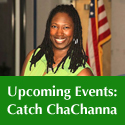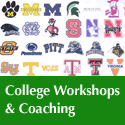I attended the Women for Hire job fair in New York to get a feel for what the Washington D.C. event would be like as a speaker.
These are my tips on what job seekers should do to maximize the opportunities at one of these events.
I attended the Women for Hire career fair in Manhattan. I’m speaking at the same event in Washington D.C. next month, and since this is a different layout than speaking gigs I’ve had before, I wanted to get the lay of the land so I had some idea what I was walking into in D.C.
It was interesting to be there without a purpose (other than reconnaissance). I was able to sit back and observe behavior, traffic flow, dress code and attitude. Career fairs are grueling marathons–there’s no doubt about it. They’re rough for the job seekers, they’re rough for the recruiters, they’re rough for the people who have volunteered their time to review resumes and the volunteers who manage the traffic flow. But I have some tips based on what I observed that will help you better navigate the event.
Tip 1: DO NOT get there early. I know, this goes against everything you’ve been taught and told by, well, just about everyone. However in this case, it doesn’t make a bit of difference if you’re looking to connect with recruiters or employers. Here’s why…
Everyone is there early, the lines are monsterously, long, painful, horrible lines. Think Disney in July-kind of lines. The lines are snaking around the escalators, it’s all bad.
Employers aren’t giving out jobs to the first 100 people they talk to, they’re giving them to the qualified people, so getting there early to be one of the first through the door doesn’t get you anywhere. After you survive the line to get into the event, then you’re going to be in lines waiting to talk to the employer, and they won’t remember the conversation because they’re overwhelmed looking at the large group of people behind you waiting to talk to them.
In the case of the Women for Hire event, it went from 10 AM until 2 PM. I got there at 11:30, and walked through the employer space to get where the speakers were presenting. The employer space was packed, wall-to-wall people. After I listened to a few of the speakers, I made my first walk-through the job fair around 12:45 and it was considerably less crowded, still busy, but you stood a chance of talking to employers. I walked through again at 1:15 before I left, and it was all but deserted. A few employers were still busy, but the majority of them were sitting behind their tables not talking to anyone.
My tip when you do approach them later in the day, be considerate of the flood of humanity they’ve just endured. Offer to let them sit down when talking to you, “I know you must be exhausted from this morning, if you want to sit down, I’m completely fine with that…I want you comfortable as we discuss how perfect I am for this job.” A little humor, a little compassion, a little tongue in cheek and you’ll stand out from the crowd, in a good way, and you’ll build a relationship. Everyone is a network, a connection to other friends and relatives who may be able to help you. If you make a favorable, memorable and professional impression on them, they may refer you to someone else who is looking for your expertise.
Tip 2: Do your research in advance. This one should go without saying, but I just want to make sure it doesn’t get overlooked. Career fairs will publish the names of companies attending. Please go to those company’s websites and check them out to see what opportunities they have. If it’s a company you haven’t heard of before, that’s an even better reason to do more thorough research. Look for ways your experience might be interesting to them: did you work for a competitor, was one of their competitors a vendor of yours? Have you done something similar in another position? Be a little creative to find the similarities–keeping in mind this is your big chance to sell yourself to them and draw the connections.
Tip 3: Talk to everyone. I don’t care who they are, chat ’em up! First, it’ll put you in a more relaxed, open state of mind. Second, this is how you network and build relationships. I’ve had some of the most fun conversations with people as I waited to pick up my luggage from an airport carousel. I make witty observations (sometimes they’re witty just to me, but we can’t hit all of them out of the park.) smile, catch other people’s eye. It builds camaraderie and will help take away some of the pressure.
As you’re waiting for a minute to talk to your target companies, talk to the people from companies that you didn’t think you were interested in. First, they may be looking to fill a job that wasn’t listed on the site or might even be opening in a month (and they don’t know about it yet). Second, if you build a relationship with them they could refer you to other companies that are hiring. Treat it as a friendly conversation, tell them what you do, what you’re looking for, say that you didn’t see anything on their site that was a fit, but hey, it’s always great to talk to new people. Recruiters are by nature very outgoing, personable people. I’m sure they’ll appreciate the change of pace and the potential of a different conversation than someone selling themselves for a specific job.
Tip 4: Don’t wear black/dark blue. That was the one thing that really struck me–how everyone looked like they dressed for a funeral. If your “interview suit” is black or dark blue, then do something to dress it up a bit. A unique pin, scarf, something to help you stand out from the crowd. I never liked the mentality that there’s only one way to dress for an interview. You should always look professional, pulled together, and neat, but that does not mean you can’t wear a figure-flattering suit in a different color. Light tan, red/maroon, dark brown–all are acceptable. I’ll never forget how I landed my first job in an impeccable Liz Claiborne mustard-colored blazer with army-green dress pants and cream pumps. I was hot, I felt it and looked it. I exuded confidence from every pore, and was offered a position on the spot.
And yes, the different color suit theory is primarily for women, but men can wear a distinctive tie or discreet lapel pin. Give people something to ask you about as a conversation starter, and start conversations with others based on questions about what they’re wearing. “That is such a unique scarf/pin/ring, there must be an interesting story behind it.” The comment is flattering and opens the door for conversation without sounding like you’re trying to pick up the opposite sex.
Tip 5: Structure your time and your booklet gathering. Here’s another thing I saw that was a little awkward. Home Depot was giving out great, large orange bags that you could use to put all the booklets/pamphlets you pick up as you wander through the employers.
The bags were great, but instantly detracted from the professional demeanor jobseekers were trying to convey.
If you have a neat briefcase to stash all the paperwork you’ll pick up, bring it or borrow one from a friend. You can still pick up the Home Depot bag, but stash it in the briefcase to take home.
If you don’t have another briefcase you can use, before you grab that flyer or brochure, consider if you’re really going to read it later. You don’t need to be schleppin’ other stuff around.
Tip 6: If the event offers a free resume review, please give the person reviewing your resume an idea of the types of jobs you’re applying for. Bring a job description and highlight some of the key phrases you see in a lot of positions so they can quickly understand your industry. If I’ve said it once, I’ve said it a million times–a resume without a target job description is much harder to give constructive feedback about. Help them help you.
And please don’t give them a resume unless it already includes your accomplishments, or if you’re not sure how to include them, discuss that specifically with the person.
Do not-under any circumstances-give them your resume and say “What do you think about this?” You’ll get a variety of feedback, some based on their personal preferences and biases (which will differ depending on the person you talk to) and some not relevant to the positions you’re applying for-combined with some advice that is actually spot on. Give them a goal and you’ll get better feedback.
Following these tips will better prepare you for your next career fair and make them a worthwhile use of your time.
Now, let’s go get some jobs!
Melanie Szlucha’s company Red Inc. Helps candidates stand out from the crowd–in a good way. Follow her on Twitter or check out her website.









Comments on this entry are closed.